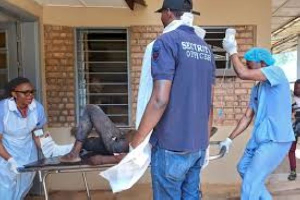First things first...let us kick off today’s instalment with hearty congratulations to the people of Ghana, employees of the National Electoral Commission and the winners. America now has a thing or two to learn from Ghana.
Meanwhile, in the midst of the election frenzy, time and tide waited for no man and real-life did indeed move on with purpose. The COVID-19 zion train chugs on as approximately 125 human beings are killed every hour – for context, that is the equivalent of two Airbus A380 aeroplanes (the largest passenger aircraft) crashing – every day. COVID-19 fatigue, the definition of which remains elusive, is now apparently a thing. Humanity has apparently accepted the new normal or is it the new abnormal. Imagine my surprise when I stumbled upon an advertisement for a COVIDIST (doctor)? These indeed are strange times.
Humanity appears to be stuck in this swirling vortex of COVID-19 fatigue universe fueled on by a vicious cycle of opportunistic nihilistic social media posts, sadistic doomscrolling habits and COVID-19 fatigue. It seems 2020 is George Orwell’s 1984, where the boundaries of public and scientific discourse are governed by multibillion-dollar corporations (in place of the totalitarian regime in Orwellian 1984) using secret algorithms coded by unidentified employees without accountability wearing catchphrases like Facebook, Twitter, YouTube and the like. We live in an age where the pen (in this case fingers and keyboards) is truly mightier than the sword and since bad news sells the most, “COVID hoaxers” and “anti-vaxxers (anti-vaccine) dominate social media posts, the more apocalyptic and melodramatic, the better.
Following the trend of the COVID hoaxers, anti-vaxxers, are set to rule our immediate future now that COVID-19 vaccines news have entered mainstream consciousness. We are going to move from scenarios of doctors having to convince people who are about to die from COVID-19 that they truly have COVID-19; from scenarios of dying COVID patients refusing to wear masks in the ICU because it “violates my right not to wear a mask” to getting insulted by “social media influencers” branding pro-vaxxers as anti-society. The insults though are actually the least of my concerns. My main concern is that these vaccine attacks might escalate in conflict areas of the world. I happened to run into this coursemate from a neighbouring West African country who reminded me that he would be branded a traitor and flogged in the public square if he spoke or discussed openly, let alone wrote about vaccines the way I so freely do.
With the vaccines already being administered in the UK as of December 8, 2020, the rubber is sure to meet the road soon enough and with it, a likely escalation of the anti-vaccine rhetoric. The battle has only just begun. Health workers and policy-makers grounded in science must be permitted to lead the charge against this pandemic of disinformation, conjecture and outright lies.
The anti-vaccine rhetoric has mostly centred on side-effects and the misconception that minorities are deliberately targeted for vaccine harm. In order to discredit these wrong perceptions, here in the USA, minority healthcare workers (Black, Hispanic, Asian and Indigenous) signed up for vaccine trials just so they could convince minority communities – who also happen to bear the direct and economic brunt of the pandemic – that vaccines are safe for minorities. Along similar lines, former Presidents George Bush and Barack Obama have both announced publicly that they believed in and would take the vaccines with their families. In the UK, the vaccines are going into both Caucasian and non-Caucasian bodies.
The impact of vaccination on the health of human beings is hard to exaggerate. According to the UN/WHO, with the exception of safe water, nothing else has had such major effect on the reduction of mortality (deaths), morbidity (illness and disability) and on population growth. Vaccines are safe and effective when stored and used correctly. However, vaccines, like other pharmaceutical products – blood pressure medications, antibiotics and so on – are not risk-free and adverse events will occasionally occur following vaccination. Adverse events become a cause of public concerns about vaccine safety. Adverse events range from minor side-effects to more severe reactions.
Although most adverse events are minor (redness at the injection site, fever) more serious reactions like convulsions occur. Adverse events have been known to occur mostly in individuals who are highly allergic, to begin with – individuals who are already required to carry prescription EpiPen and inhalers because of their high-risk allergy status. Adverse events used to be attributed to egg allergy. However, egg allergy is no longer an absolute contraindication to vaccination after epidemiologic studies found only 33 cases of anaphylaxis out of 25.1 million vaccine doses.
The WHO defines an Adverse Event Following Immunization (AEFI) as “any untoward medical occurrence which follows immunization, and which does not necessarily have a causal relationship with the usage of the vaccine”. Implicit in this definition, is the fact that AEFI may not necessarily be due to direct effects of the vaccine per se.
The WHO goes on to classify AEFI are divided into 5 categories as follows:
1. Vaccine product-related reaction (caused or precipitated by a vaccine due to one or more of the inherent properties of the vaccine product e.g., Extensive limb swelling vaccination)
2. Vaccine quality defect-related reaction (due to one or more quality defects of the vaccine product including its administration device as provided by the manufacturer e.g., Failure by the manufacturer to completely inactivate a lot of inactivated polio vaccine leads to cases of paralytic polio)
3. Immunisation error-related reaction (due to inappropriate vaccine handling, prescribing or administration e.g. Transmission of infection by contaminated multidose vial)
4. Immunisation anxiety-related reaction (anxiety about the vaccination/fear of needles may cause fainting, shallow breathing, vomiting in children)
5. Coincidental event (due to something other than the vaccine product, immunization or immunization anxiety e.g. A fever occurs at the time of vaccination but is in fact cause by malaria (temporal association).
Thus, AEFI are statistically less likely to be due to deliberate errors of human omission or commission targeted at certain groups of recipients. Other vaccine safety issues specifically applicable to the new COVID-19 vaccines – mostly driven by the speed of discovery and the technology – have been raised. Like I said in my last article, in an age of instant gratification and “now now now” mentality, it screams hypocrisy that our biggest gripe against a lifesaving scientific intervention is based on speed and efficiency of discovery. Again, I will spare you the “gory” details of the technology as it is beyond the scope to this opinion article. Suffice it to say that the COVID-19 vaccines are safe because of the technology.
That safety is a priority before, during and after vaccine development and approval cannot be overemphasized. Vaccines, like other pharmaceutical products, undergo extensive testing and review for safety. Initially, computer models and simulations study interactions between vaccine candidates and human cells. Then testing continues in animals (mice, guinea pigs, rabbits, monkeys). It is only after passing these mechanistic stages that candidate vaccines are finally tested in humans – three phases of clinical trials (Phase 1, Phase 2, Phase 3) in human beings before licensure.
Approval and licensure of the vaccine by regulatory agencies is conditioned upon analysis of these phased clinical trials data against pre-determined benchmarks of safety, immunogenicity and efficacy. Pre-licensure studies often identify common adverse events. In the last decades, numerous changes in vaccine production and administration have reduced the number of side effects and resulted in safer vaccines. For instance, vaccines no longer contain significant egg residues. While common adverse events are easily detected in pre-licensure trials, uncommon/rare and delayed adverse events are not. That is where post-licensure monitoring of vaccines (like for all pharmaceutical products) comes in.
Thus, vaccine safety continues even after approval and licensure. For instance, in the USA, the FDA requires all manufacturers to submit samples from EACH vaccine lot prior to its release. Manufacturers must provide the FDA with their test results for vaccine safety, potency and purity. The FDA, on rare occasions, has had to recall vaccine lots, for concerns, such as mislabeling, contamination during production and potential manufacturing problems at a production plant.
In conclusion, as infectious diseases become less common due to vaccines, we hear less about the serious consequences of vaccine-preventable illnesses and more about the risks associated with vaccines. It is good to be informed about health choices, but the reality is that we have never been healthier than we are today due to vaccines and vaccines have never been safer than they are today. The benefits of vaccines far outweigh the risks. Still in doubt? Simply ask the next mother or Pediatrician you run into. You may also try the following thought experiment: name just one person you know who suffered vaccine side-effects; assuming you were able to name that one person, was/were the side-effect(s) worse than the infection to be prevented by the vaccine? I rest my case. Or actually not.
I need to mention that as science continues to advance, we strive to develop safer vaccines and improve delivery to protect ourselves against disease more effectively and that these COVID-19 vaccines represent the latest destination on that never-ending journey in the quest for the ultimate perfect vaccine. Okay, now I rest my case. Truly.
Opinions of Monday, 14 December 2020
Columnist: Dr Paul C Adjei



















